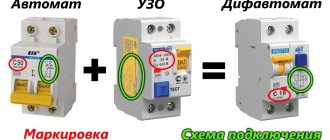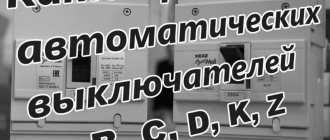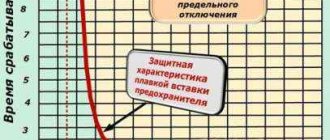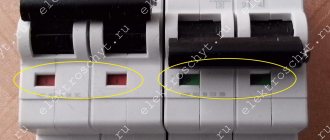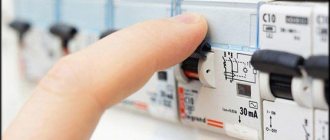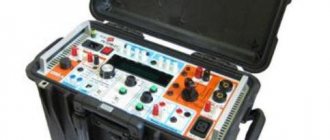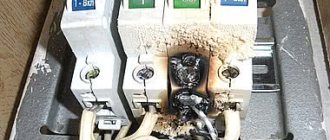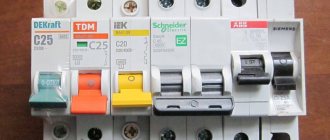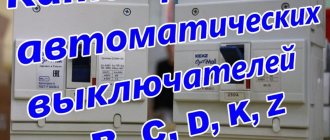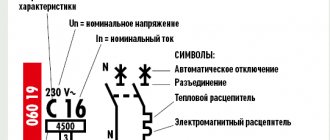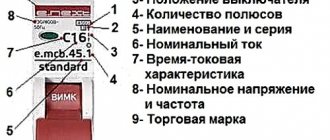High current categories:
1) over short circuit currents, when the neutral and phase conductors are directly connected to each other, bypassing the load.
Modern electromagnetic releases easily and completely accurately detect short circuits and disconnect the load in a fraction of a second, preventing even the slightest damage to conductors and equipment.
2) large currents caused by network overload (for example, the inclusion of a large number of household electrical appliances, or the malfunction of some of them);
The overload current is not much different from the rated current; for some time it can flow through the circuit without any consequences. Therefore, there is no need to turn off such current instantly, especially since it could arise very briefly. The situation is aggravated by the fact that each network has its own overload current limit. And not even alone.
Features of operation of network protection circuit breakers
Whatever class the circuit breaker belongs to, its main task is always the same - to quickly detect the occurrence of excessive current and de-energize the network before the cable and devices connected to the line are damaged.
Currents that may pose a danger to the network are divided into two types:
- Overload currents. Their appearance most often occurs due to the inclusion of devices in the network, the total power of which exceeds what the line can withstand. Another cause of overload is a malfunction of one or more devices.
- Overcurrents caused by short circuit. A short circuit occurs when the phase and neutral conductors are connected to each other. In normal condition they are connected to the load separately.
The design and principle of operation of the circuit breaker is on video:
Overload currents
Their value most often slightly exceeds the rating of the machine, so the passage of such an electric current through the circuit, if it does not drag on for too long, does not cause damage to the line. In this case, instantaneous de-energization is not required in this case; moreover, the electron flow often quickly returns to normal. Each AV is designed for a certain excess of electric current at which it is triggered.
The response time of the protective circuit breaker depends on the magnitude of the overload: if the norm is slightly exceeded, it can take an hour or more, and if it is significant, it can take several seconds.
A thermal release, the basis of which is a bimetallic plate, is responsible for turning off the power under the influence of a powerful load.
This element heats up under the influence of a powerful current, becomes plastic, bends and triggers the machine.
Short circuit currents
The flow of electrons caused by a short circuit significantly exceeds the rating of the protective device, causing the latter to immediately trip, cutting off the power. An electromagnetic release, which is a solenoid with a core, is responsible for detecting a short circuit and immediate response of the device. The latter, under the influence of overcurrent, instantly affects the circuit breaker, causing it to trip. This process takes a split second.
However, there is one caveat. Sometimes the overload current can also be very large, but not caused by a short circuit. How is the device supposed to determine the difference between them?
In the video about the selectivity of circuit breakers:
Here we smoothly move on to the main issue that our material is devoted to. There are, as we have already said, several classes of AB, differing in time-current characteristics. The most common of them, which are used in household electrical networks, are devices of classes B, C and D. Circuit breakers belonging to category A are much less common. They are the most sensitive and are used to protect high-precision devices.
These devices differ from each other in terms of instantaneous tripping current. Its value is determined by the multiple of the current passing through the circuit to the rating of the machine.
Device of automatic switches. Types of releases.
1) mechanical – for manual switching on and off,
2) electromagnetic (solenoid) – to disconnect short circuit currents,
3) thermal for overload protection.
The characteristic of thermal and electromagnetic releases is the characteristic of the circuit breaker, which is indicated by a Latin letter on the body in front of the number indicating the current rating of the device.
The characteristics of circuit breakers mean:
a) the operating range of overload protection, determined by the parameters of the built-in bimetallic plate, which bends and breaks the circuit when a large electric current flows through it. Fine adjustment is achieved by an adjusting screw that tightens this very plate;
b) the operating range of the overcurrent protection, determined by the parameters of the built-in solenoid.
Differences between AB categories B, C and D
Categories of ABCD circuit breakers are among the main indicators that deserve separate consideration and comparison. Of particular interest among classes of automata are the current time parameters of the last three categories.
A circuit breaker with characteristic D, in contrast to the ABC categories of automatic devices, is well adapted to increased overloads and is therefore installed in circuits with high inrush currents. It is traditionally used in protection circuits for powerful electric motors. When comparing machines C and B, it is important to remember that the first category of devices is more suitable for protecting household networks - for installation in a private home, for example.
Familiarity with the technical characteristics of the machines and the features of each of them will help the user choose the right device suitable for an electrical network with a given current load.
Characteristics of modular circuit breakers
There are a number of currents, for each of which it is theoretically possible to determine its maximum network shutdown time, ranging from several seconds to tens of minutes. But false alarms must also be excluded: if the current is harmless to the network, then a shutdown should not occur either after a minute, or after an hour - never at all.
1) MA – absence of thermal release. In fact, it is really not always needed. For example, protection of electric motors is often carried out using overcurrent relays, and in such a case the machine is needed only for protection against short circuit currents.
2) Characteristic A. The thermal release of the machine with this characteristic can operate already at a current of 1.3 of the rated current. In this case, the shutdown time will be about an hour. At a current twice the rated current, an electromagnetic release can be activated, operating in approximately 0.05 seconds. But if at twice the current the solenoid still does not operate, then the thermal release still works, turning off the load after about 20-30 seconds. At a current 3 times higher than the rated current, the electromagnetic release is guaranteed to operate in hundredths of a second.
Automatic circuit breakers of characteristic A are installed in those circuits where short-term overloads cannot occur in normal operating mode. An example would be circuits containing devices with semiconductor elements that can fail if the current is slightly exceeded.
3) Characteristic B The characteristic of these machines differs from characteristic A in that the electromagnetic release can only operate at a current exceeding the rated current by 3 or more times. The solenoid response time is only 0.015 seconds. When machine B is overloaded three times, the thermal release will operate in 4-5 seconds. Guaranteed operation of the machine occurs at a 5-fold overload for alternating current and at a load exceeding the rated load by 7.5 times in DC circuits.
Automatic switches of characteristic B are used in lighting networks, as well as other networks in which the starting current increase is either small or absent at all.
4) Characteristic C. This is the most familiar characteristic for most electricians. Machines C are distinguished by an even greater overload capacity compared to machines B and A. Thus, the minimum operating current of the electromagnetic release of the machine with characteristics C is 5 times the rated current. At the same current, the thermal release operates in 1.5 seconds, and the guaranteed operation of the electromagnetic release occurs at a 10-fold overload for alternating current and at a 15-fold overload for direct current circuits.
Circuit breakers C are recommended for installation in networks with mixed loads that require moderate inrush currents, which is why household electrical panels contain circuit breakers of this type.
Characteristics of circuit breakers B, C and D
5) Characteristic D – has a very high overload capacity. The minimum operating current of the electromagnetic solenoid of this machine is 10 times the rated current, and the thermal release can operate in 0.4 seconds. Guaranteed operation is provided at 20 times overcurrent.
Circuit breakers of characteristic D are intended primarily for connecting electric motors with high starting currents.
6) Characteristic K is characterized by a large spread between the maximum operating current of the solenoid in AC and DC circuits. The minimum overload current at which the electromagnetic release can operate is 8 times the rated current for these machines, and the guaranteed operation current of the same protection is 12 times the rated current in the AC circuit and 18 times the rated current in the DC circuit. The response time of the electromagnetic release is up to 0.02 seconds. The thermal release of the K machine can operate at a current exceeding the rated current by only 1.05 times.
Due to these features of the K characteristic, these machines are used to connect purely inductive loads.
7) Characteristic Z also has differences in the guaranteed operation currents of the electromagnetic release in AC and DC circuits. The minimum possible operation current of the solenoid for these machines is 2 times the rated current, and the guaranteed operation current of the electromagnetic release is 3 times the rated current for alternating current circuits and 4.5 rated current for the direct current circuit. The thermal release of Z machines, like those of K machines, can operate at a current of 1.05 of the rated current.
Z machines are used only for connecting electronic devices.
04.04.21
Performance characteristics
The main parameters of circuit breakers, which fully characterize their functionality, are generally considered to include:
- rated current (standard mode);
- ultimate breaking capacity of the device (UCC);
- current limiting characteristics;
- operation parameters of electromagnetic current protection.
The temperature characteristics, which are understood as the conditions for turning off the thermal release, are considered separately.
Characteristics of type C machine
The normal mode current is the value at which the machine can operate for as long as desired without parameters deviating from the specified norm. This value is displayed on the device body immediately following the letter defining its time-current characteristics. The maximum breaking capacity of a circuit breaker is the maximum current value at which it can operate without loss of functionality. The PKS value is indicated on the AB housing immediately below the time-current characteristic and rating.
The current limitation category characterizes the ability to disconnect the emergency line until the current reaches the overload limit. For various devices, this parameter takes the following values:
- first category – 10 milliseconds (ms) or more;
- second category – from 6 to 10 ms;
- third category – 2.5-6 ms.
The higher the current limiting category for a given model, the lower the risk of wire overheating and an emergency fire. On the front panel, the parameter is indicated under the PKS icon.
Releases and their varieties
The release is the key element of any circuit breaker. It has the function of blocking the power supply if the current exceeds the permissible value. At the same time, there are two types of such devices that can be equipped with a circuit breaker - thermal or electromagnetic.
The latter are distinguished by the fact that with their help, almost instantaneous operation of the protective system is achieved, and the section is immediately de-energized as soon as the occurrence of a short circuit is detected. The design includes a coil with a core, which, under the influence of a strong current, is drawn inward, which is why the tripping element is constantly activated.
There are remote-type devices that not only block, but also return the energy supply without the need to go to the electrical panel yourself. However, these options significantly increase the overall price of the equipment.
Why is labeling necessary?
For a qualified electrician, the front panel of the machine is like an open book - in a couple of minutes he can find out everything about the device, from the manufacturer to the rated current value. An experienced installer can easily distinguish between devices that are absolutely identical from the point of view of the average person.
A homeowner unfamiliar with the intricacies of electrical wiring can also understand the information provided by the manufacturer.
Using special symbols located on the front panel, you can distinguish the machine from the RCD, find out its main technical characteristics and find out in what sequence the wires are connected.
To clarify information about a specific device, just open the door of the metal cabinet in which metering and protection devices are installed: all symbols are visible
Information about a separate circuit breaker may be required if:
- it is necessary to replace the device;
- you should select a new machine due to the appearance of an additional circuit;
- it is required to compare the rated current load of the line and the circuit breaker;
- you need to find the cause of the emergency shutdown, etc.
Some symbols become intuitive, while others require certain knowledge to decipher. If you are planning to replace the wiring yourself or connect a circuit breaker, it is better to study information about the devices in advance.
Choosing the right machine
How can you understand how many kilowatts a 16-amp machine can withstand in practice?
The most common correct way to select a circuit breaker is:
- determine the wire cross-section
- according to the rules of electrical installations, find the current that is permissible for such a wire cross-section
- select the machine that suits these parameters
For example, there is a copper wire with a cross section of 1.5 sq. mm. The current allowed for it is a maximum of 18-19 amperes. Accordingly, according to the rules, you need to choose a suitable machine, but with a downward shift according to the table. And this turns out to be 16 amperes. That is, you can install a 16 amp machine.
If the wire is copper and its cross-section is 2.5 sq. mm, then only a current of up to 26-27 amperes is allowed. Therefore, the maximum you can use is a 25-amp machine. Although, for reasons of reliability, it is better to install a 20-amp machine.
In this way, the parameters of the required machine for the remaining wire sections are calculated.
Automatic machines with unregulated and adjustable releases.
The current setting of the 0.4 kV circuit breaker release is designated as Ir and for some devices it can vary within a fairly wide range in relation to the rated current of the circuit breaker. For example, for thermomagnetic releases this range is usually equal to (0.7-1)*In, for modern electronic releases - (0.4-1)*In. These are machines with a “variable characteristic release”
In Fig. Figure 1 shows the time-current characteristic of such a machine - Compact NSX with a TM-D release.
Fig.1 Operation characteristics of the TM-D release and its control currents. (from the catalog Compact NSX 100-630 A, Schneider Electric)
The entire graph in Fig. 1 is plotted in relative units of current Ir, as evidenced by the inscription below. That is, first you select Ir in fractions of In and then look at the tripping characteristic of the release in Fig. 1 in fractions of Ir.
In Fig. 1 there are three characteristic points for the thermal release (this is our protection against cable overload according to PUE 3.1.11):
- This is the rated current of the release Ir;
- Guaranteed non-trip current Int, equal to 1.05*Ir;
- Guaranteed release current It (also known as the tripping current of the release), equal to 1.2*Ir.
The required test current for cable overload protection according to PUE 3.1.11 is the starting current It
, i.e. current at which the release is guaranteed to turn off the circuit breaker within the control time. Let's remember this result.
Now let’s give an example of a machine with a “release with a non-adjustable characteristic”. For this, a conventional modular automatic machine iC60 and its time-current characteristic at a control temperature (30 degrees C) are suitable. The shutdown characteristic (B,C,D) can be anything - we are not interested in it now.
For such a machine, the rated current of the release is equal to the rated current of the machine, Ir = In. Then, according to the characteristics in Fig. 2, we get the same three points characteristic of any release:
- Rated current of the release Ir;
- Guaranteed non-trip current Int, equal to 1.13*Ir;
- Guaranteed release current It (also known as the tripping current of the release), equal to 1.45*Ir.
But in this case, according to the same paragraph of the PUE, the test current will be exactly the rated current of the release Ir
, not It. That is, a current that differs by 45% from what would be used with an adjustable release! You can read the definition in paragraph 3.1.11 again. and see for yourself.
Attention: if the physical meaning of the characteristics of both types of releases is absolutely the same, then why is there a difference in the methods for testing them under the conditions of overload protection? How can the ability to regulate Ir affect the test control current? And anyway, what the hell?
The first time I saw this, I thought that I had gone crazy and it was time for me to finish calculating the settings. Because, according to this point, it turned out that I did not understand anything about this matter. Then I decided to get to the bottom of the issue and find out who separated these brothers-disconnectors. I started digging on these Internets of yours for all the available information. Years passed... And finally I discovered the original source. Make yourself comfortable, now there will be a denouement
Rated current (In)
This is the maximum value of current that a circuit breaker equipped with a special overcurrent trip relay can carry indefinitely at the ambient temperature specified by the manufacturer, without exceeding the specified maximum temperature of live parts.
Example
Circuit-breaker with a rated current In = 125 A at an ambient temperature of 40 °C, equipped with an overcurrent tripping relay suitably calibrated (set to 125 A). The same circuit breaker can be used at higher ambient temperatures, but at the expense of underrating. For example, at an ambient temperature of 50 °C, this switch will be able to carry 117 A indefinitely, but at 60 °C, only 109 A, provided that the specified temperature requirements are met.
The rated current of the circuit breaker is reduced by reducing the setting of its thermal relay. The use of an electronic release that can operate at high temperatures makes it possible to operate circuit breakers (with reduced current settings) at an ambient temperature of 60 °C or even 70 °C.
Note:
In circuit breakers conforming to IEC 60947-2, the current In is usually equal to Iu for the entire switchgear, where Iu is the rated continuous current.
